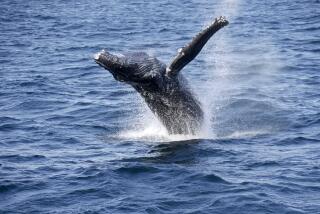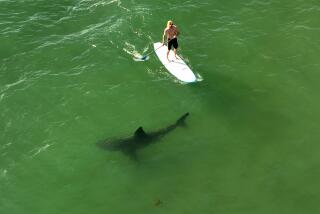Subsurface Moorings Not a Hazard : Theyâre All Part of Extensive Federal Oceanographic Study
The 10 temporary subsurface moorings established in the San Pedro Channel and the Gulf of Catalina, as reported in the Coast Guardâs July 16 Local Notice to Mariners, are not a hazard to navigation. A quartermaster in the Aids to Navigation Office said that, although the moorings are not marked, they are placed well below the surface, the highest one being set 180 feet below the surface.
But why? It turns out that the moorings have measuring devices that primarily monitor ocean currents, unlocking secrets of the deeps off our coast until now unknown.
It is an extensive oceanographic study, funded by the federal Department of Energy with the University of Washington, Oregon State University, USC, UCLA and Scripps Institute, San Diego taking part. Heading the ongoing project is Dr. Barbara M. Hickey, a physicist at the University of Washington.
Hickey, in a telephone interview, said the moorings will be hauled late in October. Her primary interest is in ocean currents of the deeps. However, the project involves other important oceanographic studies. Other devices on the submerged buoys, at various depths, are measuring temperature, salinity, pressure and oxygen.
Sediment traps also have been installed. Along with currents, automatically measured every 20 minutes, the kind and direction of movement of sediment, possibly containing pollutants, can be traced.
The study, extending over at least a three-year period, was begun last year, with the first set of submerged, instrumented buoys set down off Santa Monica Bay and near the City of Los Angelesâ Hyperian ocean outfall line. These buoys were set down from May to October.
Preliminary data, Hickey said, indicates that prevailing, strong underwater ocean currents, up to a knot in speed, circulate in a northerly direction over the slope of the continental shelf, while weaker currents circulate up on the shelf in a southerly direction. Currents, of course, are affected by winds. She also is studying wind directions and plans to use data recorded by the National Weather Service at such points as recorded on instruments at Atlantic Richfieldâs oil-drilling platform about seven miles off Huntington Beach and at the end of the Long Beach breakwater.
The Department of Energy is primarily interested in what happens to âenergy-related byproducts.â In other words, it wants to find out how man is affecting his marine environment with chemicals, sewage, oil drilling and the effects of nuclear-energy generation, Hickey said.
âOur goal is primarily oceanographic research. We are not out there to point the finger at any particular industry. For the first time, this study will give us an integrated view of what is going on out there.â
In addition, 12 to 15 other scientists from other disciplines are concurrently studying marine flora and fauna, the results of which will be coordinated with the data from the submerged buoys.
The coordinates of the 10 buoys range from about 33 degrees 19 minutes and 33 degrees 55 minutes North and 117 degrees 37 minutes and 119 degrees 16 minutes West. This places several of them between Newport Beach and Santa Catalina Island and the others between Catalina and San Clemente Island.
Sailing Notes
The Southern California Marine Assn. is holding its American Boating Jubilee â86, a display of new boats and marine equipment, at the Shoreline Village Marina in Long Beach tomorrow through Aug. 3. . . . Latest odds, by Americaâs Cup 1987 Report, published in Newport, R.I., rate the U.S. challengers thusly: San Diego YC (Sail America), 4-1; New York YC (America II), 5-1; Newport Harbor YC (Eagle), 12-1; Chicago YC (Heart of America), 12-1; St. Francis YC (Golden Gate), 25-1; and Yale Corinthian YC (Courageous), 50-1. . . . A 1,000-mile swim from Southern California to waters off Cabo San Luca, Baja California, has set the record for the longest documented migration of a Pacific Ocean shark, according to Dennis Bedford, state Fish and Game biologist. The shark, caught off Cabo, had a DFG tag on it.
More to Read
Sign up for Essential California
The most important California stories and recommendations in your inbox every morning.
You may occasionally receive promotional content from the Los Angeles Times.










